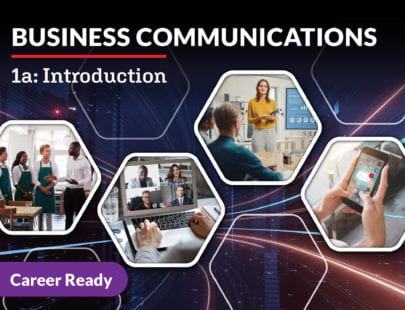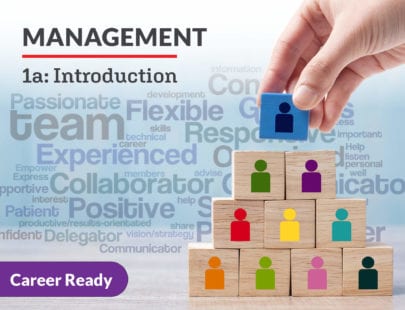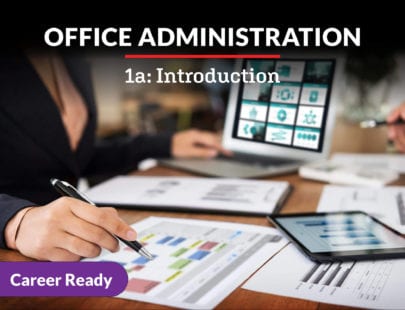
Professional Sales and Promotion 1a: Introduction
“Sell me this pen.” It seems like an easy request, but the art of selling takes nuance, expertise, and an ability to navigate the complexities of client needs. In this course, you’ll learn about the bigger picture of the sales cycle. You’ll examine the role of today’s sales professional along with the skills and qualities needed for success, and you’ll learn the ins and outs of the sales process and how it is driven by recognizing and responding to customer needs. Before long, you’ll be a part of the well-oiled engine that drives the entire commercial economy. But first, can you sell me this pen?
Units at a Glance
Unit 1: The Sales Profession
Every time a business transaction occurs, two actions are occurring simultaneously: both buying and selling are taking place. To achieve both of these activities, an interaction between multiple people must often take place. In addition to the activity of the buyer, there’s also an important counterpart acting on the selling side of a purchase transaction. The wide range of actions performed by the selling party helps to ensure a successful transaction. This role functions as part of the profession known as sales, or selling. These skilled businesspeople use their abilities, knowledge, and experience to make personal connections with customers. Career opportunities abound in the sales profession, and selling actually comes in a variety of forms—all of which are shaped by the specific industry, geography, and particular sales role. Selling professionals can continue to build their knowledge and skills by gaining job experience, increasing education, and pursuing professional development through a number of industry pathways. Through focus and dedication, professional sellers are often able to achieve long-term success in highly rewarding sales careers.
What will you learn in this unit?
- Describe the nature of selling as a profession
- Explain the importance of the selling profession to the economy
- Identify career opportunities within the selling profession
- Detail educational and training pathways used by the selling profession
Unit 2: The Professional Seller
Because all products and services usually transfer from a selling party to a buying party, you will find salespeople in all corners of the business world. All industries need capable salespeople at each step of a distribution channel, and it’s not a static role. Sellers perform a wide variety of functions for their organizations, all while using a wide range of styles and activities. Every salesperson is trained to perform according to whatever they’re selling and on the specific needs of their customers. Whether the offer is a product or a service, or whether it’s to an individual customer or a business, a professional seller’s degree of success will be determined by their level of service and how well they manage their customer relationships.
What will you learn in this unit?
- Describe the various types of sales roles within the profession
- Explain various styles of selling
- Outline and compare selling to businesses versus selling to end customers
- Compare and contrast selling physical products and intangible services
Unit 3: Skills to Sell Successfully
Making a sale is something that should be pretty familiar to all of us. Consider the fact that we sometimes influence other people—whether friends, family, or even strangers—to change their behavior. This is a form of selling. When we persuade others to act as we’d like them to, we do so by drawing on specific skills commonly used in professional selling. But occasionally persuading others to modify behavior is one thing, whereas regularly influencing customers to complete a purchase for a product or service is quite a different story. Salespeople in all fields must develop and use a unique set of skills to be successful, and those skill levels differ depending on the strengths and weaknesses of the person doing the selling. Successful salespeople have the ability to assess their own capacities for selling. They’ve learned to leverage their strengths while also working to improve upon their weaknesses. Salespeople who work consistently to improve their skills tend to achieve long-term success in the profession. Beginning with an assessment of their own mix of personal attributes, sellers are able to set achievable goals aimed at building their particular skill sets—something they’ll continue to monitor and develop over the course of their careers.
What will you learn in this unit?
- Explain key success factors for high-achieving sales professionals
- List valuable characteristics of people in the selling profession
- Identify essential skills needed to communicate effectively with customers
- Describe how salespeople can develop skills for continuous job improvement
Unit 4: The Role of Marketing in Sales
Focusing on customer wants and needs is the key to a company’s success, and two departments within any organization are responsible for working together to direct and manage that focus. Those are the sales and marketing teams. The marketing department traditionally focuses on activities directed to large groups of customers, while the sales department works to identify interested individuals from within those groups so they can convert that interest into business transactions. Providing a positive customer experience depends largely on these two departments working together well as a team. But before a sale can be made, the company must first get their offerings and messages out to the customers. This is the function of marketing. Using a mix of strategies, marketing first identifies who the customer is and then works hard to satisfy them. Sales and marketing operate as distinct departments within a business, but they both focus on the single most important person to a company—the customer.
What will you learn in this unit?
- Outline the relationship between marketing and sales teams within an organization
- Define and explain the four Ps of the marketing mix
- Describe how an organization segments, targets, and positions their products and services to customers
- Explain the promotional mix and how companies use communications to sell their offerings
Unit 5: The Role of Sales in Marketing
Marketing teams all over the world focus their efforts on activities that communicate their messages to their customers. Advertising and public relations are both examples of the marketing practices that play a role in a company’s overall strategy to get the word out to their target markets. Practices that make up this promotional mix all aim to make a connection with the customer, but the one practice of the promotional mix that connects with the customer in real time is personal selling. While general marketing focuses on an overall selling strategy, sellers interact directly with customers to close sales in real time. Sales teams research, analyze, and assemble materials designed to help their salespeople to complete sales transactions. By using marketing materials to connect with customers and build business relationships, salespeople realize the many marketing objectives with each and every transaction.
What will you learn in this unit?
- Recognize the responsibilities of the sales department
- Assess factors that signal a selling opportunity
- Identify the information used to determine new customer opportunities
- Describe various approaches to sales prospecting
Unit 6: Understanding Customer Needs
Professional sellers focus much of their time and energy on making close connections with customers. This starts with a deep understanding of who the customers are and how they buy. Customers tend to follow a particular process when making both personal and business buying decisions. Salespeople must thoroughly understand how this process works to be able to guide the customer through the stages of the purchasing process. And because each customer has different needs and motives for making a purchase, sellers must also recognize various customer types and the differences between them. Gaining a solid understanding of the customer’s role, characteristics, and process is every salesperson’s challenge. Only then can a salesperson close the sale and shift their focus to providing quality customer service after the sale is complete.
What will you learn in this unit?
- Describe the stages that make up the purchasing process
- List key reasons why customers buy
- Identify and compare various types of customers
- Explain why customer service is an important step in the purchasing process
Unit 7: The Selling Process
Just as a customer moves through a series of steps in a particular process before making a purchase, professional salespeople also progress through the steps of their own process on the selling side of a transaction. This process guides their interactions with customers—from the initial interest to the final purchase—and every step of the selling process mirrors its own analogous step within the buying process. You can think of the sales process as the map that helps the seller navigate the sales terrain on the journey from encountering a new opportunity to closing a transaction with a paying customer. By following the repeatable steps in this process, salespeople anywhere can benefit by selling more and working more effectively with customers.
What will you learn in this unit?
- Describe the steps in the selling process and the techniques used at each one
- Analyze how the sales process can be mapped to the customer’s buying process
- Identify success factors for negotiating and closing business transactions
Unit 8: Communications in Sales
Success at each step of the selling process relies on several factors, but all of it boils down to clear communication. Everything—from the first contact with a new prospect, to developing relationships, asking questions, presenting, and closing the sale—requires skills in various types of communication. Selling activity is built on two or more individuals interacting with each other, discussing issues, making discoveries, and then reaching potential solutions. This can take place either when buyers and sellers are both in the same room or when they are within a virtual setting. Skilled communication on the part of sellers is ultimately what moves the sales process forward, eventually leading to closed transactions. Knowing what types of communication are needed, and when, and then using those specific types effectively, is exactly what leads sales professionals to achieve success with customers.
What will you learn in this unit?
- Describe various communication methods used during the selling process
- Compare interactions with customers in face-to-face, digital, and sales-call environments
- Identify common customer objections and appropriate strategies sellers can employ to handle them effectively
Required Materials
Physical
- Art supplies
- Audio recording device
- Digital camera
- Video recording device
Software
- Graphic design software
- Presentation software
- Task management software
- Word processing software
Other
- Helpers (three)
Optional
- Sales professionals for interview



